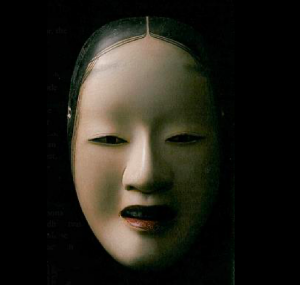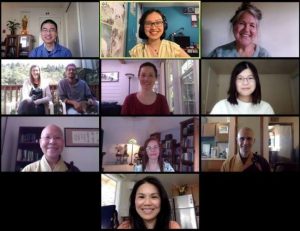
The following is a translation of an article that was originally published by Buddhistdoor en Español.
This work is a continuation of the earlier article “In Pandemic Times: Reflecting on Futures and How Buddhist Values and Practices are Contributing” and taking a further step in the configuration of sociological analysis imbued with Buddhist methodology. The fusion of both worldviews through coinciding elements provides us with the opportunity to transcend the parts, the individual, and to look at the global or social. On this occasion, the interaction between the values and actions of Buddhists results in a map of interconnections in the form of a network showing interdependence and paths. I approach the Buddhist social world by focusing on one of its central dimensions: social paths to and from happiness.
It is an exercise that draws on the ideas and concepts derived from roads and maps, something that Buddhists are familiar with. Maps and paths are commonly utilized in Buddhism to describe personal development, movement toward happiness, nirvana, and enlightenment, or in terms of a spiritual path, a path of salvation, and so on. The social aspect is here defined both by the aggregate of individuals and by actions and values toward others. And the maps and roads are the result of the interactions between those values and social actions.
Happiness is one of the central elements in the Buddhist narrative and worldview, and its pursuit translates into paths—of practices—to attain it. And a substantial part of these paths is social insofar as it has to do with our relationships with other beings. Therefore, these ideas go beyond the individual dimension—of being merely individual practices of individual paths—and involve social values and opinions, as well as social actions and practices, involving relationships with others. Concepts including not-self, dependent origination, emptiness, non-duality, the law of karma, the idea of the bodhisattva, loving-kindness, and the Four Immeasurables all imply interrelations with other beings aimed toward their well-being and happiness. And those interrelations can be used to draw a social map depicting paths to happiness.
This analysis is based on the Buddhist logic of dependent origination, interconnection, and continuous transformation that, together with the law of karma, define a complex causal interaction model—causes and conditions in continuous interaction, drawing both narratives and paths.
Happiness, being cause and effect at the same time, is interconnected with other elements, configuring a complex network of causal interactions. In order to visualize it as a social space and understand it as a road map, we use correlations between the values and practices of Buddhists, collected in the World Values Survey, as a contact simile and as an existing path between pairs of points.
The relationships between pairs of elements—values and actions—become conceptually connected as contacts and paths. From this matrix of binary relationships, we move to the interconnections between all values and practices. Its graphical representation is a network in which we can analyze and visualize not only the relationships that shape that space but also the paths to and from happiness.
Practices and values are part of the Buddhist toolbox, and just as the combination of tools offers a range of possibilities to work, the combination of values and practices draws multiple connections and social paths.
Roads to happiness
Fig. 1 represents the system of strong causal interactions shaping the social map of happiness. It shows a structure made up of multiple paths connecting directly or indirectly to all the points representing values and actions. Those belonging to the same dimensions—of equanimity, religiosity, love, social position, or quality of life—tend to appear close to each other and are located in differentiated spaces on the map according to their relationship systems.

To the left of the social map, we find the indicators of equanimity and vision of others (in blue), and in the upper right we find indicators of religiosity (in fuchsia). The entire social space is connected by elements of love (nodes in yellow) crossing it from top to bottom. Key social position indicators (nodes in red) along with those of quality of life and happiness (in green) are situated in the center of the bottom of the map.
The links between indicators show a circular causal dynamic connecting the entire system in a continuous flow. In this structure of paths, the variables/indicators of love stand out as intermediaries and bridges between happiness and the left part of the social system, as well as between the left and right sides—between equanimity and religiosity. Love is key in facilitating the continuous causal flow in the system.
Happiness, which is located in the center of the lower part of the map in Fig. 1, is surrounded by elements including love, social position, quality of life, and religion—represented larger in size and with a thicker connecting line. In the happiness neighborhood—represented in detail in Fig. 2—we see love, exemplified by the importance given to friends and family, together with social position, represented by social class and income, and quality of life, as health and satisfaction with life, as well as religion, represented by its importance. In this community, it is worth highlighting that the indicators of quality and enjoyment of life—health, satisfaction, and happiness—are related to indicators of material well-being as well as love for others.

Fig. 2: Network of direct relationships with happiness. Image courtesy of the author
The rest of the of the social system, including indicators of equanimity and trust, along with religiosity and love in the form of actions toward others, is two steps away from happiness and is reachable through its neighbors. These neighbors connect happiness with the rest of the system, forming a circuit of causal interaction. The equanimity-trust dimension connects with happiness most directly through love. Religiosity does so directly as well as indirectly through health, and also through the causal circuit formed by love in the form of actions toward others, in the upper central part. This continues through equanimity and trust in the others and love again—importance of others, at the bottom.
Two main causal circuits stand out. The first is that of well-being and quality of life, with reciprocal causality—from Happiness to well-being and from well-being to happiness. And a broader circuit is formed by happiness, love, equanimity/trust, religion, and happiness (shown in Fig. 3). Here, happiness is part of a broad causal avenue that links to love—through importance of family and friends—which connects to trust and equanimity, linked in turn to love in the form of actions toward others. This in turn is connected to religiosity, which is finally linked to happiness. They form a causal circuit in both directions that show us the paths to happiness—happiness being the result of the social path—and happiness as a causal and change force—contributing to happier societies through love for others.

Fig. 3: Paths to and from happiness. Image courtesy of the author
Following Buddhist causal logic, we could think about quality of life and well-being more as conditions, and about values and actions toward others as causes. The two circuits represent two different causal dimensions: one (as conditions) facilitates the possibility of the causal effect and the other (as cause) is responsible for changes in other elements.
The relevance of quality of life and social position’s direct relationships with happiness lies, apart from being partially causal, in their role as facilitators (or limiters) of causal impacts. That is, they create existential conditions that enable and enhance the effects of social values and practices leading to happiness.
As a conclusion to this social mapping tour
I have looked at this issue with a kind of Buddhist sociology that fuses concepts from Buddhism with sociological concepts. The law of karma is comparable to causal effects, and dependent origination and interrelation are similar to correlations. Some of these are central in the Buddhist vision and the others are central in the sociological vision.
This look has shown Buddhism as a social practice oriented toward others and toward happiness, seen both in individual as in collective and social terms. In the interrelation between values and practices emerges a narrative social structure telling a story of paths to happiness. The Dalai Lama’s central narrative—of love, compassion, and happiness—describes these social paths well.
By being able to represent the social map in which happiness is inserted, we see two complementary systems that cross it. These are the path of material well-being through the conditions and quality of life (at the bottom of the map) and the path of love through orientation and action towards others, connecting the whole system.
In short, multiple paths shape the two main avenues to and from happiness—one of material well-being that is more individual and the other of equanimity and values and actions of love toward others that is more social. It is a kind of communication circuit in both directions—leaving happiness and leading to more harmonious and happy societies on the one hand, and towards happiness in the opposite direction as the result of the social path.
Related features from BDG
Our Happiness Is Interconnected with That of Others
Social Relations and COVID-19
Joy and Happiness
Making a Difference: Radical Happiness
Discovering Radical Happiness
Happiness
Cuong Lu’s The Buddha in Jail: 52 Vignettes on Discovering Freedom and Happiness Within












